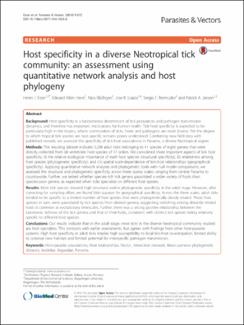Mostrar el registro sencillo del ítem
Host specificity in a diverse Neotropical tick community: an assessment using quantitative network analysis and host phylogeny
| dc.contributor.author | Esser, Helen J. | |
| dc.contributor.author | Herre, Edward Allen | |
| dc.contributor.author | Blüthgen, Nico | |
| dc.contributor.author | Loaiza, Jose R. | |
| dc.contributor.author | Bermúdez, Sergio E. | |
| dc.contributor.author | Jansen, Patrick A. | |
| dc.date.accessioned | 2020-07-04T08:41:13Z | |
| dc.date.available | 2020-07-04T08:41:13Z | |
| dc.date.issued | 2016-06-29 | |
| dc.identifier.other | https://doi.org/10.1186/s13071-016-1655-6 | |
| dc.identifier.uri | http://repositorio-indicasat.org.pa/handle/123456789/174 | |
| dc.description | Background: Host specificity is a fundamental determinant of tick population and pathogen transmission dynamics, and therefore has important implications for human health. Tick host specificity is expected to be particularly high in the tropics, where communities of ticks, hosts and pathogens are most diverse. Yet the degree to which tropical tick species are host-specific remains poorly understood. Combining new field data with published records, we assessed the specificity of tick-host associations in Panama, a diverse Neotropical region. Methods: The resulting dataset includes 5,298 adult ticks belonging to 41 species of eight genera that were directly collected from 68 vertebrate host species of 17 orders. We considered three important aspects of tick host specificity: (i) the relative ecological importance of each host species (structural specificity); (ii) relatedness among host species (phylogenetic specificity); and (iii) spatial scale-dependence of tick-host relationships (geographical specificity). Applying quantitative network analyses and phylogenetic tools with null model comparisons, we assessed the structural and phylogenetic specificity across three spatial scales, ranging from central Panama to countrywide. Further, we tested whether species-rich tick genera parasitized a wider variety of hosts than species-poor genera, as expected when ticks specialize on different host species. Results: Most tick species showed high structural and/or phylogenetic specificity in the adult stage. However, after correcting for sampling effort, we found little support for geographical specificity. Across the three scales, adult ticks tended to be specific to a limited number of host species that were phylogenetically closely related. These host species in turn, were parasitized by tick species from distinct genera, suggesting switching among distantly related hosts is common at evolutionary timescales. Further, there was a strong positive relationship between the taxonomic richness of the tick genera and that of their hosts, consistent with distinct tick species being relatively specific to different host species. Conclusions: Our results indicate that in the adult stage, most ticks in the diverse Neotropical community studied are host specialists. This contrasts with earlier assessments, but agrees with findings from other host-parasite systems. High host specificity in adult ticks implies high susceptibility to local tick-host co-extirpation, limited ability to colonize new habitats and limited potential for interspecific pathogen transmission. | en_US |
| dc.description.abstract | Background: Host specificity is a fundamental determinant of tick population and pathogen transmission dynamics, and therefore has important implications for human health. Tick host specificity is expected to be particularly high in the tropics, where communities of ticks, hosts and pathogens are most diverse. Yet the degree to which tropical tick species are host-specific remains poorly understood. Combining new field data with published records, we assessed the specificity of tick-host associations in Panama, a diverse Neotropical region. Methods: The resulting dataset includes 5,298 adult ticks belonging to 41 species of eight genera that were directly collected from 68 vertebrate host species of 17 orders. We considered three important aspects of tick host specificity: (i) the relative ecological importance of each host species (structural specificity); (ii) relatedness among host species (phylogenetic specificity); and (iii) spatial scale-dependence of tick-host relationships (geographical specificity). Applying quantitative network analyses and phylogenetic tools with null model comparisons, we assessed the structural and phylogenetic specificity across three spatial scales, ranging from central Panama to countrywide. Further, we tested whether species-rich tick genera parasitized a wider variety of hosts than species-poor genera, as expected when ticks specialize on different host species. Results: Most tick species showed high structural and/or phylogenetic specificity in the adult stage. However, after correcting for sampling effort, we found little support for geographical specificity. Across the three scales, adult ticks tended to be specific to a limited number of host species that were phylogenetically closely related. These host species in turn, were parasitized by tick species from distinct genera, suggesting switching among distantly related hosts is common at evolutionary timescales. Further, there was a strong positive relationship between the taxonomic richness of the tick genera and that of their hosts, consistent with distinct tick species being relatively specific to different host species. Conclusions: Our results indicate that in the adult stage, most ticks in the diverse Neotropical community studied are host specialists. This contrasts with earlier assessments, but agrees with findings from other host-parasite systems. High host specificity in adult ticks implies high susceptibility to local tick-host co-extirpation, limited ability to colonize new habitats and limited potential for interspecific pathogen transmission. | en_US |
| dc.language.iso | eng | en_US |
| dc.rights | info:eu-repo/semantics/openAccess | |
| dc.rights | http://creativecommons.org/licenses/by/4.0/ | |
| dc.subject | Host-parasite associations | en_US |
| dc.subject | Host relationships | en_US |
| dc.subject | Vector | en_US |
| dc.subject | Interaction network | en_US |
| dc.subject | Mean pairwise phylogenetic distance | en_US |
| dc.subject | Ixodidae | en_US |
| dc.subject | Argasidae | en_US |
| dc.subject | Panama | en_US |
| dc.title | Host specificity in a diverse Neotropical tick community: an assessment using quantitative network analysis and host phylogeny | en_US |
| dc.type | info:eu-repo/semantics/article | en_US |
| dc.type | info:eu-repo/semantics/publishedVersion |

